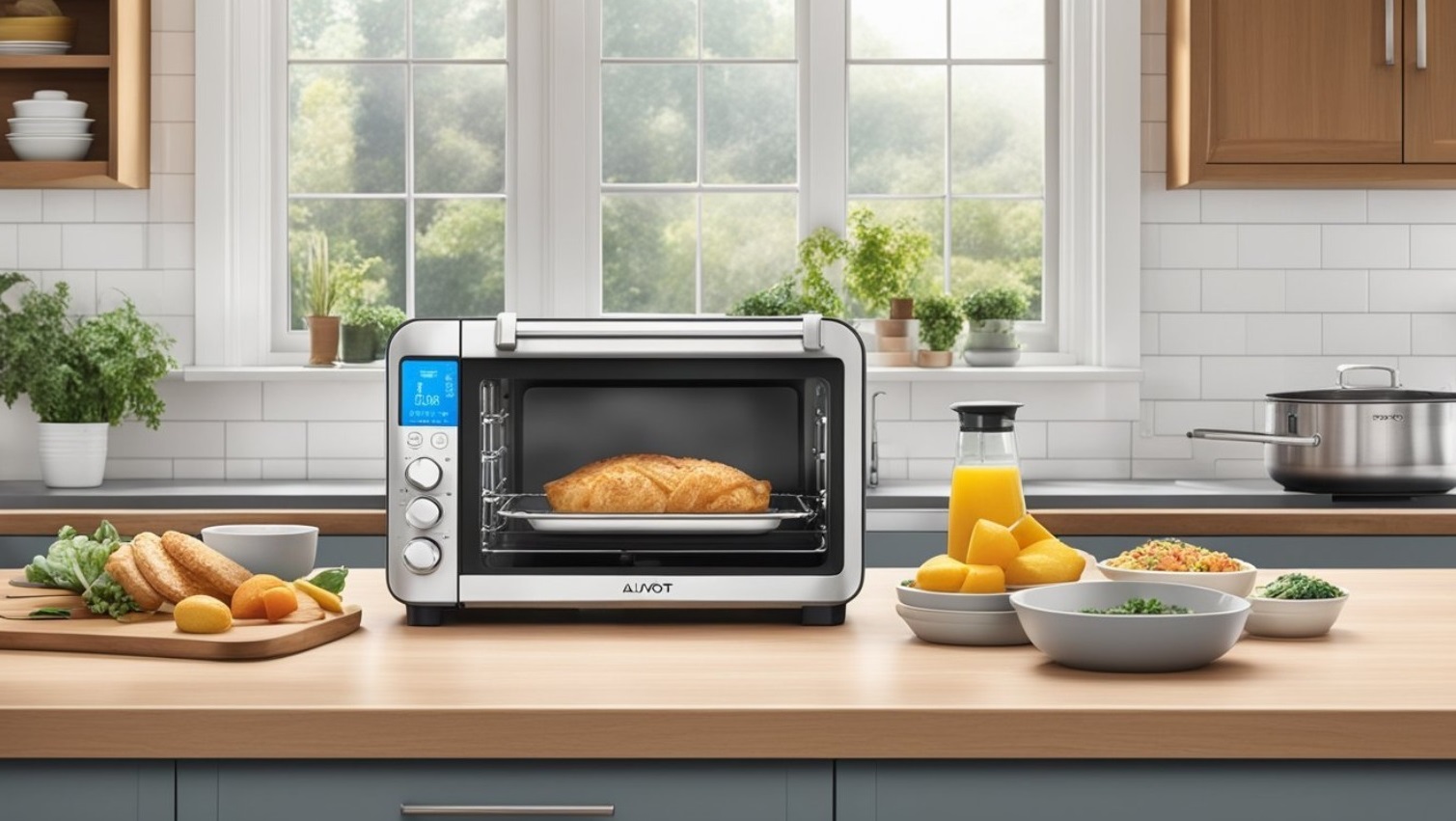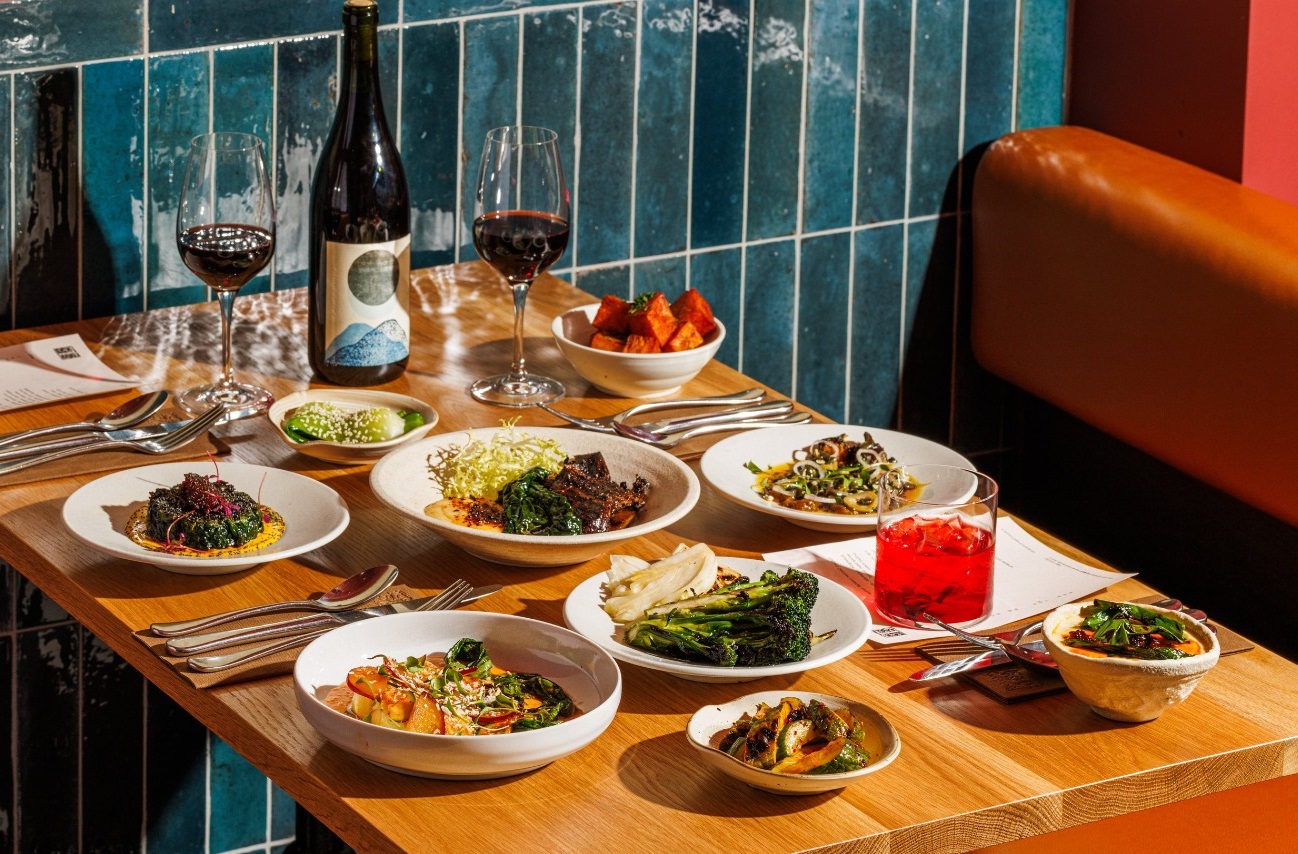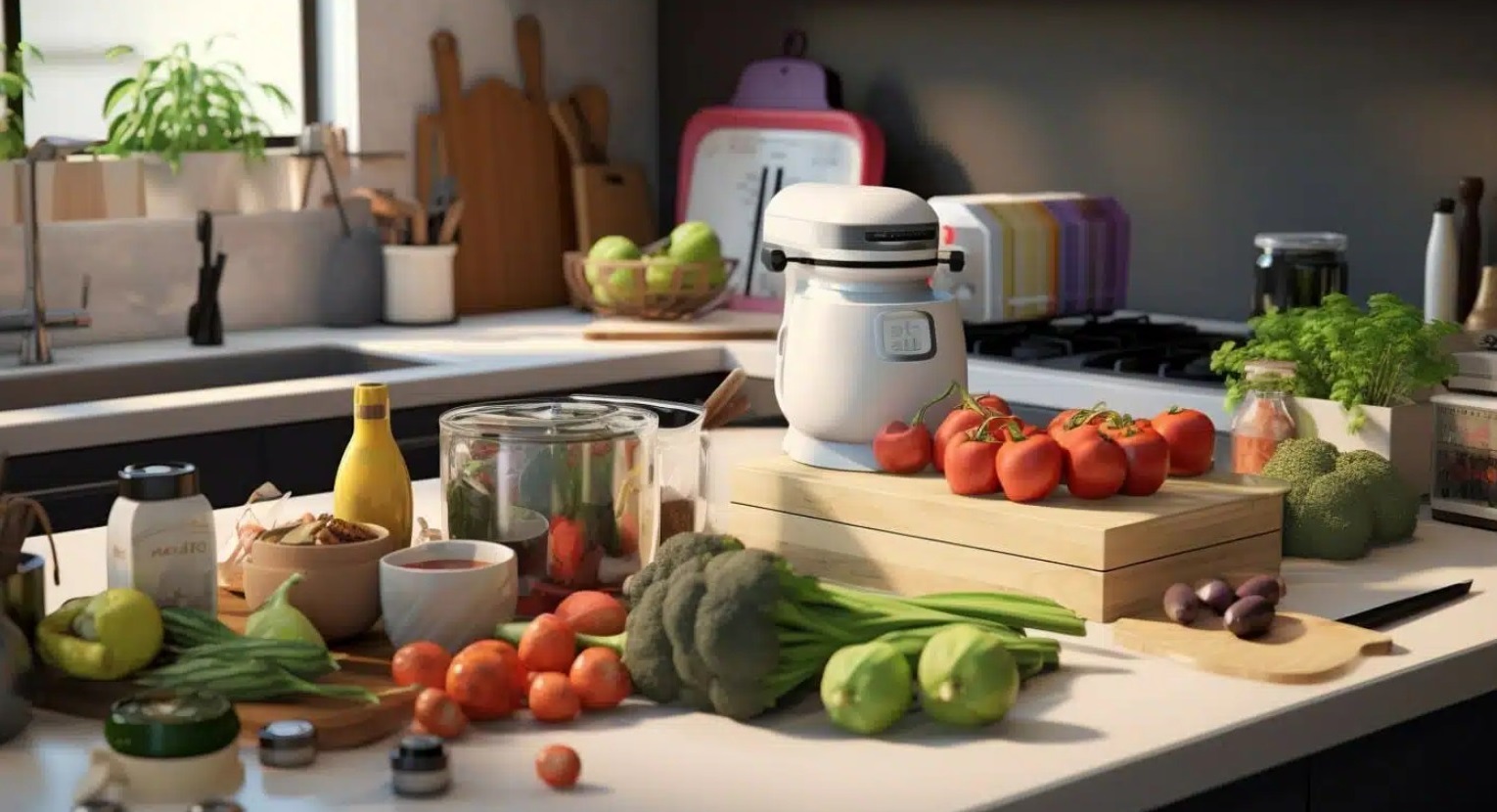Healthy eating patterns, especially vegetarian and vegan, are becoming a trend and a lifestyle for many people. However, many people also eat a diet low in meat but lots of fruit and vegetables. With well-thought-out equipment and clever additions, a vegetarian kitchen can be adapted to a healthy and vital lifestyle. We show what makes a modern vegetarian kitchen.
New cooking pleasures in the vegetarian kitchen
Currently, about one in ten people in Germany follow a vegetarian or vegan diet, and it is estimated that there are more than one billion vegetarians worldwide. There are many reasons to adopt a diet that avoids animal products, but vegetarians and vegans are very concerned about animal welfare, climate and environmental protection. But giving up meat, fish and dairy products doesn’t mean you must say goodbye to delicious food. Quite the contrary: Many greens are completely reinventing classic ways of preparing food and experimenting with a wide variety of fruits and vegetables, venturing into new concoctions or preparing meat substitutes in such a way that they can easily compete with conventional schnitzel or spaghetti Bolognese.
Of course, cooking and preparing things becomes much fun when there is enough space in the kitchen, fresh herbs are available, and essential kitchen equipment is nearby. We’ll show you how you can set up a kitchen specifically for your vegetable needs, which tools are efficient, and which organizational aids will ensure you never lose track of the kitchen again. By the way, the vegetarian kitchen is for more than just vegetarians and vegans. Kitchen appliances provide more space for cooking, growing and seasoning healthy meals, which should sound tempting to hobby cooks even without vegetarian tendencies.
Kitchen for vegetables – how it differs from a “normal” kitchen.
As in most kitchens, in a fully equipped kitchen for vegetarians and vegans, you will find a refrigerator, a stove with an oven, and a sink area and worktop where food is prepped and prepared. However, the first differences with conventional cooking can already be identified here: Vegetarians and vegans cook differently than people who eat meat. Meat or meat substitute products are no longer used in vegetable dishes. Instead, fresh vegetables and herbs take centre stage, and specific kitchen tools are used more intensively than others. For example, refrigerators are designed primarily to keep vegetables and fruit fresh.

Since vegetarianism and veganism are no longer just nutritional trends but rather reflect an attitude to life, the preparation of dishes is also different. Many vegetarians and vegans consciously take time and enjoy working on their recipes. Fresh fruit and vegetables replace convenience and ready-made products, and meal preparation is celebrated uniquely. On the one hand, you know exactly what ingredients are in each food. However, on the other hand, you develop a very different understanding of healthy and delicious foods in which flavour enhancers or additives and colourings have no place. Gardeners can even grow their own vegetables, such as tomatoes, zucchini, or cucumbers, in the summer. But even without a garden, fresh herbs or sprouts can be planted beautifully in small flower pots in the kitchen so that fresh ingredients can always be used.
Planning and equipping a vegetarian kitchen
Anyone who likes to cook healthily needs plenty of space, practical tools, and innovative accessories that make working in a vegetarian kitchen easier. With our planning tips, you can optimally match your kitchen furniture to your cooking habits.
Sufficient storage space
If you look at the menu of a mixed diet eater, vegetables, beans, and nuts often play a secondary role. Frequently, they are used as a side dish for schnitzel, currywurst or steak. However, because vegetarian cuisine is so varied and varied, it makes sense to plan enough storage space in the kitchen. After all, kitchen cupboards should have room for fresh fruit and vegetables and a variety of dry supplies such as nuts, grains, rice, or legumes. Kitchen cupboards with internal pull-outs or apothecary cupboards, for example, are very suitable as storage cupboards because, on the one hand, they provide much space. On the other hand, they give a good overview of all the food.

Nowadays, more and more “no packaging” shops are being set up where you can get food and supplies without packaging. Instead, you bring your container and fill it with leftovers. On the one hand, this means you get the right amount of rice, beans or pasta as needed, and on the other hand, you protect the environment from further plastic waste. Lightweight bamboo containers are ideal for shopping. When you get home, supplies can be stored correctly and in a glass drawer or screw-top jar for a long time.
Although some fruits and vegetables are stored well in the refrigerator, others do not tolerate cold well. To maintain the taste and aroma of tomatoes, peppers, or bananas, these foods should be stored at room temperature. Storage systems such as baskets or pull-out boxes are ideal for potatoes, apples, onions, or carrots.
Spacious work surface
Different types of vegetables are often used to prepare delicious casseroles and colourful wok and wok dishes. Onions should be cut into rings, tomatoes into cubes, and bell peppers into strips. The extensive work surface ensures you have enough space when cutting and prepping. A worktop made of Dekton or stainless steel is ideal here. Not only does it look modern, but it is also very hygienic and easy to maintain. If the room is large enough, planning the kitchen island as a pure preparation area is worth considering. The entire work surface can be used since there is no sink or stove.
Good lighting
Good lighting in the work area is beneficial in several ways. This way, you can immediately see whether the lettuce is ready to eat after washing or whether there is still dirt on the leaves. You can see at a glance whether pressure marks or remaining cores from fruits and vegetables must be removed. Good lighting also ensures a high level of safety. After all, very sharp knives are often used when cutting and preparing food.
Space for kitchen equipment
Depending on individual preferences, smoothie makers, juicers or grain mills, vegetable slicers, and food processors are used in vegetarian kitchens. For a neat kitchen appearance, appliances are put into blind cupboards or tall cupboards after use. Corner base cabinets with shelves that can be moved upwards when necessary hide kitchen utensils and utilize the space in the corner of the kitchen to save space.

Multifunctional sink area
A well-designed sink area ensures kitchen tasks go hand in hand: rinsing, drying, peeling and chopping. For this purpose, a multifunctional built-in sink is an excellent choice. A double sink with practical accessories is ideal: Special cutting boards and containers can be hung on the sink. A kitchen faucet with a pull-out showerhead is also beneficial for easily washing giant vegetables such as zucchini or cucumbers. A shower hose also makes filling the cooking pot with water easy if, for example, a delicious vegetable soup is on the menu.
This goes into organic waste.
Tomato stems, zucchini tips or banana peels – a vegetarian kitchen produces much organic waste, so an extra-large organic waste container is essential. Equipped with a lockable lid, no odour comes out. It is convenient if organic waste is placed in a waste separation system with other waste containers under the sink. With a trash container embedded directly in the kitchen table, organic waste can be disposed of more quickly.
Socket with USB port
Sufficient power outlets are needed so that all kitchen equipment, such as a smoothie maker, grain mill, or food processor, can be powered by electricity, especially in a vegetable kitchen. Retractable sockets can be hidden in the worktop to keep the kitchen looking attractive. Socket systems with integrated USB ports are also very popular. A tablet can be connected here to instantly try out the latest vegetable recipe ideas.

Fresh herbs from the kitchen garden
Fresh herbs give each dish an unmatched taste and ensure that vegetarian meals are enjoyable. A kitchen herb garden ensures you always have chives, parsley, mint, thyme or other herbs at home. Now, a practical solution makes integrating a kitchen garden easy: plant boxes with an exceptional lighting system support growth so plants can survive without direct sunlight. Potted herbs also feel great on a windowsill or in a planted balcony flower box, supporting healthy and aromatic cooking.
Spice drawer
Dried spices and herbs are often used in vegetarian cooking to give vegetarian dishes a special taste. Kitchen cabinets for spices, oils, and vinegar make organizing things easy and help you find jars and jars of specific spices. It’s best to sort herbs and spices alphabetically or by group so you can find the right jar quickly.
Technology and kitchen equipment for the vegetarian kitchen
In a vegetarian kitchen, technical equipment should certainly be addressed. Various devices are used to support a healthy and varied diet.

Oven and steamer for healthy preparation
Besides the refrigerator, the oven is probably the most significant electrical appliance in a vegetarian kitchen. You can use it to make delicious cakes and muffins, as well as delicious breads and casseroles. Toasted granola mueslis is also very tasty and is served for breakfast with a bit of honey, dried cranberries and nuts.
Steamers are available as separate electrical appliances or integrated into the oven. They allow gentle cooking so vegetables remain crunchy and their vitamins are preserved. Sous-vide cooking is also popular. Vacuum-packaged food is prepared in a steamer at a low temperature.
Refrigerator with different cooling zones
The refrigerator may need to be more prominent in a vegetarian kitchen. It mainly stores fresh ingredients such as fruits, vegetables and spices. Since lettuce, savoy cabbage, or pak choi require a relatively large space, a spacious refrigerator with different cooling zones is essential. Separate boxes allow other foods to be stored separately and clearly. Modern refrigerators are equipped with a 0° cooling zone where the vitamins and minerals in food are retained for a very long time.
By the way, not all fruits and vegetables are suitable for storing in the refrigerator. Tropical fruits, tomatoes and zucchini lose their aroma at low temperatures, so they are best stored in a protected place at room temperature.
Induction cooker with cooking accessories
Works, grill plates, and Teppan Yaki plates are practical additions to a conventional stove for various vegetarian dishes. With cooking accessories, you can prepare delicious vegetable dishes in no time and benefit from low energy consumption.
Extractor hood with trough hood
Steaming vegetables and cooking potatoes produce fumes that must be vented using a powerful extractor hood. Stoves with integrated extractor hoods called downdraft fans extract smoke and odours where they arise – directly from the stove.
Food processor for multifunctional use
With a food processor, you can quickly prepare delicious smoothies full of vitamins. With the proper attachment, a food processor can perform various tasks, such as slicing vegetables, kneading bread dough, or chopping nuts. Additionally, this device is ideal for making hot sauces, dips or salad dressings. When purchasing, it is essential to look for a powerful food processor with sharp blades so that nuts or ice cubes do not cause problems for the mixer.
The vegetarian kitchen doesn’t just appeal to vegetarians and vegans
A balanced, healthy and vitamin-rich diet is becoming increasingly important. Ethical questions that address sustainable population supply or global climate protection affect us all and influence our eating habits. It’s no surprise that the number of vegetarians, vegans and flexitarians continues to increase.
A vegetarian kitchen meets the requirements for a varied diet rich in vitamins and minerals. Here, you’ll find plenty of space to store fresh food, you can spread out freely when cutting and preparing food, and you even have the opportunity to grow your own herbs—which seems like the perfect solution for any hobby cook who also loves food. Meat and fish are occasionally on the menu.

The Ultimate Guide to Creating Delicious and Nutritious Meals in Your Vegetarian Kitchen
Are you fed up with the usual vegan meals? Are you yearning for flavorful and wholesome dishes that will leave you fully content? Search no more! In this comprehensive manual, we will demonstrate how to produce delectable and nourishing meals right in your vegan kitchen.
Whether you’re an experienced cook or a complete novice, our manual offers something for everyone. With a wide range of vegan options available, we’ll assist you in enhancing your culinary skills and bringing out the flavors in plant-based ingredients.
From appetizing breakfast suggestions to fulfilling dinner recipes, we’ve got you covered. Explore the versatility of vegetables, legumes, and grains as we walk you through creating meals that are not only delicious but also packed with essential nutrients.
Prepare to unleash your creativity and experiment with unique flavor combinations. With our expert advice and methods, you’ll be able to prepare meals that will impress even the most doubtful meat-eaters.
Whether you’re aiming to introduce more plant-based meals into your diet or simply want to expand your vegan cooking repertoire, this manual is for you. So grab your apron and get ready to elevate your vegan cooking to the next level.
Health advantages of a vegan diet
A well-organized vegan diet can offer numerous health benefits. One of the primary benefits is the increased consumption of fruits, vegetables, whole grains, and legumes, which are rich in essential vitamins, minerals, and antioxidants. These nutrient-dense plant-based foods can help reduce the risk of chronic diseases such as heart disease, type 2 diabetes, and certain types of cancer.
Moreover, a vegan diet is usually lower in saturated fat and cholesterol, which can contribute to improved heart health. Studies have demonstrated that vegans often have lower blood pressure, lower cholesterol levels, and a reduced risk of developing heart disease compared to their non-vegan counterparts. Furthermore, a plant-based diet can aid in weight management, as these foods are generally lower in calories and higher in fiber, which can promote feelings of fullness and satisfaction.
Apart from the physical benefits, a vegan lifestyle can also have positive effects on mental health. The increased consumption of fruits, vegetables, and whole grains has been linked to enhanced mood, reduced symptoms of depression, and improved cognitive function. The diet’s emphasis on whole, unprocessed foods can also contribute to a healthier gut microbiome, which has been shown to influence various aspects of physical and mental well-being.
Key components in a vegan kitchen
Establishing a well-equipped vegan kitchen is the cornerstone for creating tasty and nourishing meals. At the heart of a vegan pantry are a variety of whole grains, such as quinoa, brown rice, oats, and whole wheat pasta. These nutrient-dense carbohydrates provide sustained energy, fiber, and a range of essential vitamins and minerals.
Legumes, including lentils, chickpeas, black beans, and kidney beans, are also fundamental in a vegan kitchen. These protein-rich foods can be utilized in a wide variety of dishes, from hearty stews and chilis to flavorful dips and spreads. Incorporating a variety of legumes into your meals ensures a balanced intake of plant-based protein, fiber, and complex carbohydrates.
Vegetables, both fresh and frozen, are the foundation of a vegan diet. From leafy greens like spinach and kale to vibrant bell peppers, zucchini, and mushrooms, these nutrient-dense foods offer a wealth of vitamins, minerals, and antioxidants. Maintaining a well-stocked supply of versatile vegetables enables you to create a diverse range of dishes, from roasted vegetable medleys to flavorful stir-fries.
Healthy fats, such as avocado, nuts, seeds, and extra-virgin olive oil, are also essential in a vegan kitchen. These fats not only add richness and flavor to your meals but also provide essential fatty acids that support overall health. Including these healthy fats can help you feel more satisfied and nourished after your vegan meals.
Lastly, a well-stocked spice rack is crucial for adding depth and complexity to your vegan dishes. From aromatic spices like cumin, coriander, and turmeric to savory herbs like basil, thyme, and rosemary, these flavorful ingredients can transform simple plant-based ingredients into vibrant, satisfying meals.
Meal planning for vegetarians
It is essential to plan your vegetarian meals effectively to ensure they are both tasty and nutritionally balanced. Begin by evaluating your dietary requirements and preferences, considering any dietary restrictions or health issues you may have. This will help you develop a meal plan that meets your specific needs and guarantees that you receive all the necessary nutrients your body requires.
When preparing your vegetarian meals, concentrate on integrating a variety of whole, unprocessed foods. This includes plenty of fruits, vegetables, whole grains, legumes, nuts, and seeds. Strive to incorporate a diverse range of colors, textures, and flavors in your meals to keep things interesting and satisfying.
One effective approach to meal planning is to create a weekly or bi-weekly menu outlining your planned meals and snacks. This not only assists you in staying organized and on track but also enables you to make efficient use of your time and resources. Consider batch cooking or meal prepping on weekends to have healthy, ready-to-go options throughout the week.
When planning your vegetarian meals, be mindful of incorporating a balance of macronutrients (carbohydrates, proteins, and healthy fats) to ensure you’re meeting your body’s energy and nutrient needs. Pay attention to plant-based protein sources, such as beans, lentils, tofu, tempeh, and seitan, to ensure you’re getting adequate amounts of this essential nutrient.
Additionally, ensure that you include a variety of micronutrients, such as vitamins, minerals, and antioxidants, by incorporating a wide range of fruits, vegetables, and whole grains into your meals. This will help support overall health and well-being.
Simple and fast vegetarian recipes for beginners
For individuals new to vegetarian cooking, the idea of creating delightful and satisfying meals can appear overwhelming. However, with a few straightforward and quick recipes, you can easily begin your plant-based culinary journey.
One timeless and adaptable dish is the vegetable stir-fry. This dish allows you to feature a variety of fresh or frozen vegetables, such as broccoli, bell peppers, carrots, and mushrooms. Simply sauté the vegetables in a flavorful sauce, such as teriyaki or garlic-ginger sauce, and serve over a bed of whole grain rice or quinoa for a complete and nutritious meal.
Another uncomplicated choice is the vegetarian burrito bowl. Start with a base of cooked brown rice or quinoa, then top it with your choice of plant-based protein (such as black beans or tofu), sautéed vegetables, avocado, salsa, and a sprinkle of shredded cheese or a dollop of plant-based yogurt. This dish is not only delicious but also highly customizable to your taste preferences.
For a quick and satisfying breakfast, consider a veggie-packed frittata. Beat together eggs (or a plant-based egg substitute) with your favorite vegetables, such as spinach, tomatoes, and bell peppers, and bake until set. Serve it alongside a slice of whole grain toast for a nutritious and filling start to your day.
Soups and stews are also excellent options for beginner vegetarian cooks. Lentil soup, minestrone, or a hearty bean chili can be prepared in a single pot, making them easy to assemble and packed with plant-based nutrients. Pair these comforting dishes with a fresh salad or a slice of crusty bread for a complete and satisfying meal.
Finally, do not underestimate the power of a simple vegetable-based pasta dish. Toss whole grain pasta with sautéed vegetables, a flavorful tomato sauce, and a sprinkle of vegan cheese or toasted nuts for a quick and delicious dinner option. The possibilities are endless when it comes to creating easy and nutritious vegetarian meals.
Tips for creating flavorful vegetarian dishes
Creating tasty vegetarian dishes relies on building layers of flavor, which can be achieved through various techniques and the strategic use of ingredients. To begin, cook your vegetables by sautéing or roasting them to bring out their natural sweetness and depth of flavor. The caramelization that occurs during these cooking methods can significantly enhance the taste of your plant-based ingredients. Experiment with different cooking techniques, such as grilling, steaming, or pickling, to discover new ways of highlighting the flavors of your vegetables.
Incorporating a variety of herbs and spices is another crucial step in creating flavorful vegetarian dishes. Aromatic spices like cumin, chili powder, and paprika, as well as fresh herbs like basil, cilantro, and oregano, can transform even the simplest of dishes. Experiment with different combinations and find the ones that best complement the other ingredients in your recipe.
Umami-rich ingredients, such as soy sauce, miso paste, or mushrooms, can also add a savory depth of flavor to your vegetarian meals. These umami-packed components can help balance out the sweetness or acidity in your dishes, creating a more well-rounded and satisfying flavor profile. Another tip for enhancing the flavor of your vegetarian dishes is to incorporate healthy fats, such as avocado, nuts, or extra-virgin olive oil. These fats not only add richness and mouthfeel but also help to carry and amplify the flavors of your other ingredients.
Finally, don’t hesitate to experiment and play with different flavor combinations. Mixing sweet, sour, salty, and spicy elements can create a dynamic and enjoyable eating experience. Embrace your creativity and don’t be afraid to step outside of your comfort zone – you might just discover a new favorite vegetarian dish in the process.
Incorporating plant-based proteins into your meals
Including plant-based proteins in your meals is essential to ensure adequate protein intake for those following a vegetarian diet. There are many delicious and nutritious plant-based protein sources that can be easily incorporated into your meals.
Legumes, such as lentils, chickpeas, black beans, and kidney beans, are versatile and protein-rich additions to vegetarian dishes. These nutrient-dense foods can be used in various ways, from hearty stews and chilis to flavorful dips and spreads.
Tofu, tempeh, and seitan are also excellent plant-based protein sources that can be used in a wide range of vegetarian recipes. Tofu is a highly versatile ingredient that can be marinated, baked, or stir-fried to create a variety of textures and flavors. Tempeh offers a heartier and more textured alternative, while seitan can mimic the texture of meat in vegetarian dishes.
Nuts and seeds, such as almonds, walnuts, and chia seeds, are another valuable source of plant-based protein. These nutrient-dense ingredients can be enjoyed on their own as snacks, incorporated into salads and grain bowls, or used in baking and cooking.
For a quick and convenient protein boost, consider incorporating high-protein grains like quinoa, amaranth, or teff into your meals. These ancient grains not only provide a satisfying texture but also deliver a substantial amount of plant-based protein.
When planning your vegetarian meals, aim to include a variety of plant-based protein sources to ensure you’re getting a well-rounded intake of essential amino acids. Experiment with different combinations and cooking methods to keep your meals interesting and nutritionally balanced.
Creative ways to use vegetables in your cooking
There are numerous creative ways to use vegetables in your cooking, making them the foundation of a vibrant and nourishing vegetarian diet. Beyond the classic side dishes and salads, vegetables can be used as the star of the show in a variety of innovative and delicious recipes.
One versatile way to utilize vegetables is by using them as the base for plant-based burgers, meatballs, or “meat” loaves. Finely grated or pureed vegetables, such as mushrooms, lentils, or cauliflower, can be combined with binding ingredients like breadcrumbs or chia seeds to create satisfying and nutrient-dense vegetarian patties or meatballs.
Vegetables can also be transformed into creative and flavorful noodle alternatives. Spiralized zucchini, sweet potato, or carrot “noodles” can be used in place of traditional pasta, creating a low-carb and nutrient-rich option for your favorite pasta dishes. These vegetable noodles can be tossed with pesto, marinara sauce, or a variety of other sauces for a satisfying and nourishing meal.
An alternative method for utilizing vegetables is to incorporate them into baked goods and desserts. Grated or blended vegetables, such as carrots, beets, or zucchinis, can be mixed into muffins, cakes, and quick breads, adding moisture, sweetness, and nutritional value. Experiment with different combinations of vegetables to create unique and delightful treats.
Roasted vegetables can also take center stage in your meals. By tossing various vegetables like Brussels sprouts, cauliflower, and sweet potatoes with a drizzle of olive oil and your preferred seasonings, you can create a flavorful and satisfying side dish or the foundation for a hearty vegetarian main course.
Lastly, do not overlook the versatility of vegetables in smoothies and juices. Leafy greens, such as spinach and kale, can be blended with fruits, nut butters, and other nutrient-dense ingredients to create a nutrient-packed beverage that can serve as a snack or a meal replacement. The possibilities are endless when it comes to using vegetables in creative and delicious ways.

How to prepare vegetarian versions of popular dishes:
One of the pleasures of following a vegetarian diet is the opportunity to re-create classic dishes in a plant-based manner. By employing creative substitutions and techniques, you can savor the flavors and textures of your favorite meals without the necessity of animal-based ingredients.
For instance, a traditional spaghetti and meatballs dish can be transformed into a vegetarian version by using lentils, mushrooms, or a mix of plant-based proteins to make the “meatballs.” Combine these with your preferred tomato sauce and whole grain spaghetti for a satisfying and nutritious meal.
Another well-liked dish that can be easily adapted is the veggie burger. Instead of relying on a store-bought patty, you can craft your own flavorful and nutrient-dense version using a mixture of beans, grains, and vegetables. Top it with your favorite condiments and serve it on a whole grain bun for a delightful and fulfilling vegetarian burger experience.
Chili is another dish that lends itself well to a vegetarian transformation. Substitute the ground meat with a variety of beans, lentils, and chopped vegetables, such as bell peppers, onions, and tomatoes. Season it with a blend of spices, and you’ll have a robust and comforting vegetarian chili that can be relished on its own or served over a baked potato or rice.
For a vegetarian twist on tacos or fajitas, use a combination of sautéed vegetables, such as mushrooms, bell peppers, and onions, as the protein base. Top them with your favorite toppings, such as avocado, salsa, and a sprinkle of vegan cheese, for a delectable and satisfying plant-based meal.
When it comes to breakfast, you can easily create vegetarian versions of classic dishes like omelets or quiches by using a plant-based egg substitute, such as tofu or chickpea flour, and filling them with a variety of sautéed vegetables and plant-based cheese alternatives.
The key to successfully re-creating popular dishes in a vegetarian manner is to focus on bold flavors, creative substitutions, and a variety of textures. Experiment with different ingredients and techniques to find the combinations that best suit your taste preferences and nutritional needs.
Conclusion: Enjoying the benefits of a vegetarian kitchen
Crafting delicious and nutritious meals in your vegetarian kitchen is a journey of exploration, creativity, and personal satisfaction. By embracing the wide range of plant-based ingredients available and exploring new cooking techniques, you can unlock a world of flavorful and satisfying vegetarian dishes that will nourish both your body and your taste buds.
Whether you’re a seasoned vegetarian or just beginning to explore the advantages of a plant-based diet, this ultimate guide has equipped you with the knowledge and inspiration to elevate your vegetarian cooking to new levels. From understanding the health benefits of a vegetarian diet to mastering the art of creating flavorful vegetarian dishes, you now have the tools to transform your kitchen into a vibrant, plant-based oasis.
As you continue your vegetarian culinary journey, remember to embrace the versatility of vegetables, legumes, and whole grains, and don’t be afraid to experiment with new flavors and combinations. By focusing on nutrient-dense, whole-food ingredients and incorporating a variety of cooking techniques, you can create meals that are not only delicious but also nourishing and satisfying.
Ultimately, the joy of a vegetarian kitchen lies in the opportunity to nourish your body, support your overall health, and explore the boundless creativity that plant-based cooking has to offer. So, don your apron, gather your ingredients, and embark on a culinary adventure that will leave you feeling energized, inspired, and proud of the delicious and nutritious meals.
